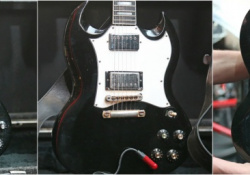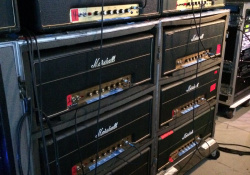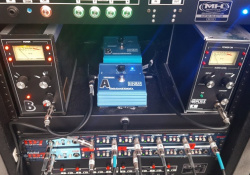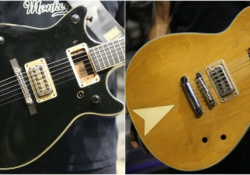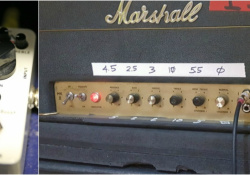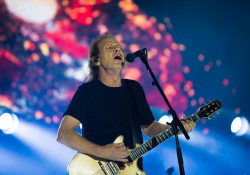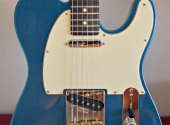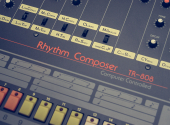
Guitar Gear of the Titans of Rock, AC/DC (2015-16 Rock or Bust tour)
When the brothers Malcolm and Angus Young formed AC/DC in Sydney, Australia, in 1973, they probably had no idea of the success the hard rock quintet would achieve over the years. To date, the band has sold more than 150 million albums, Back in Black sits at No. 2 on the best-selling albums chart with 42 million copies, AC/DC was inducted into the Rock and Roll Hall of Fame in 2003 and, perhaps most importantly, the band continues to sell out shows around the world despite personnel issues.
In the mid-seventies, when they released the studio albums High Voltage (1975), T.N.T. (1975), and Dirty Deeds Done Dirt Cheap (1976), the position of bassist was held by Mark Evans. He was replaced by Cliff Williams in 1977, the only change in personnel until singer Bon Scott died of acute alcohol poisoning in February 1980.
Scott's successor was Brian Johnson, and the Young brothers had a lucky hand in this choice. Brian's screaming style fit perfectly into the band's sound and his expressive delivery was a big part of the huge success of Back in Black (1980), which occupied the top of the US and UK charts and went platinum the year after its release.
The first half of the 1980s was not a happy time for AC/DC—the band did record a reasonably successful CD, For Those About to Rock We Salute You (1981), but long-time member Phil Rudd was fired for his excessive drug use and replaced by Simon Wright, who stayed with the band for nine years and contributed to five rather mediocre albums.
Studio session player Chris Slade sat on the drum stool from 1989, was replaced by returnee Rudd from 1994 to 2015, and then rejoined AC/DC. After a not-so-significant period came a better times with the well-received albums The Razors Edge and Stiff Upper Lip, as well as several live recordings on DVD, and AC/DC seem to be back in full swing.
The end of 2014 sees the release of Rock or Bust, but unexpected problems hit the band. In addition to the departure of Phil Rudd, founding member Malcolm Young is forced to leave the band due to health reasons and is replaced by his nephew Stevie Young, and another blow is Brian Johnson having to drop out of the ongoing tour in March 2016 due to hearing problems.
AC/DC decide to resume the tour after a short break and the eccentric Axl Rose of Guns N' Roses takes over the role of frontman, which is not exactly to the liking of many die-hard fans.
The following overview of the two guitarists' stage gear is based on the American leg of the 2015-16 Rock or Bust tour.
Angus Young
Guitars:
Angus's favorite model is a vintage 1967 Gibson SG in black lacquer fitted with a pair of special Seymour Duncan humbuckers with 7.8 kOhm resistance and several potentiometers. His second SG, with a white pickguard, is a 1970 Gibson SG Custom, with which Young toured extensively in the 1980s on the Back in Black tour.
Serving as backup guitar is a 1963 Gibson Custom Brian Ray SG, which Ray, a big AC/DC fan, gave to Young years ago. Young then had it modified to his specifications. The guitar has a modified neck profile, the Bigsby vibrato has been replaced with a solid tune-o-matic fingerboard and the company pickups have been replaced with custom Seymour Duncan humbuckers. The instruments are covered with Ernie Ball Super Slinky strings in 9-42 gauge, and the most used picks are Fender Extra Heavy versions.
Amps and boxes:
On tour, Angus's roadies carry nine Marshall Super Lead 100-watt amps, which were modified years ago and given a master potentiometer to adjust overall output. Since most of these Marshalls are constantly cranked up to the maximum, Simon Murton, the engineer, has to check the power tubes and adjust the bias before every gig just in case.
Typical stage equipment includes fifteen to twenty-five (depending on stage size) straight Marshall BX 4x12 cabinets equipped with twenty-five watt Celestion Greenback speakers. The signal is picked up by a single microphone and then mixed with the sound of an isolated 2x12 box located backstage.
Effects:
Angus Young has never been a fan of pedalboards packed with tons of effects. His effects rack includes Shure Axient wireless receivers, Mike Hill's special amp switchers, and a new addition in the form of a Schaffer Replica Tower wireless system. This custom model, built by Phil Olivieri of SoloDallas, is an exact copy of the Schaffer-Vega Diversity System series that Young used in the late 1970s, and original developer Ken Schaffer built in a signal-loss compensating, slightly sustain-enhancing preamp at Angus' request.
A pair of Rocktron HUSH box noise gates are used to eliminate unwanted noise, and the signal is split by two Radial JD7 Injector splitters. A very important part of the Angus sound is the Kikusui PCR4000M Power Supply rackmount power supply and voltage converter, which feeds 236V into the Super Leads, which, while the power tubes suffer, increases the projection and gain of the Marshalls.
Stevie Young
Guitars:
Stevie Young decided not to experiment too much with stage gear and adopted most of it from his cousin Malcolm. His main instrument on the Rock or Bust tour was a 1963 Gretsch G6131 Jet Firebird, which was Malcolm's #2 guitar in the past. The vintage model, in natural lacquer, only has a bridge humbucker (the neck and middle pickups have been removed) and all the electronics have been dismantled except the volume control.
The backup was given to him by Malcolm—a black, originally left-handed 1963 Gretsch G6131 Jet Firebird with a bridge humbucker (neck pickup again removed) and no electrics, which Stevie used back in his Starfighters days.
Another specialty is a replica of Malcolm Gretsch's Firebird made by the British company Jaydee Custom Guitars, which also supplied instruments for Black Sabbath's Tony Iommi. On this guitar, again, only the bridge pickup was kept, a volume control added, and the Burns vibrato was replaced with a classic solid bridge.
Newer models include the Gretsch Jet Firebird from the company's Custom Shop, where experienced guitar maker Stephen Stern took over production. The guitar, in an impressive gold metallic finish, is this time fitted with both humbuckers, full electronics with three potentiometers and the same number of switches and a Burns vibrato.
Amps and boxes:
The six old Marshall amps consist of Malcolm's favorite 1971 Marshall Super Bass, three 1966 and 1967 Marshall JTM45 100-watt amps, a 1967 Marshall "Black Flag" Super Lead, and another 1976 Marshall Super Bass serving as backup.
The amplifiers without any modification are complemented by six 4x12 Marshall 1960 BV cabinets fitted with Celestion Vintage 30 speakers, and the signal from the boxes is mixed with the sound of a single 1967 Marshall JTM45 100W combined with an isolation box.
Effects:
The only effect used by Stevie Young on the tour was the Mooer Pure Boost booster, and that was only for the track "T.N.T." The bass and treble of the effect are slightly suppressed, while the mids are pulled up and the Gain potentiometer is set to minimum, so the booster is used more as a three-band equalizer.
What else would you like to know about the gear of the greats? Let us know in the comments below.
If you have found an error or typo in the article, please let us know by e-mail info@insounder.org.

